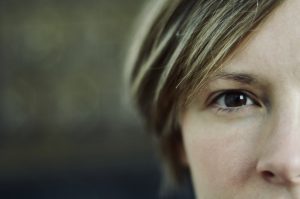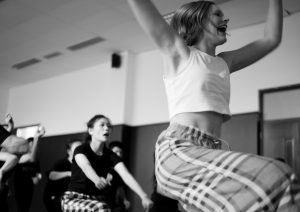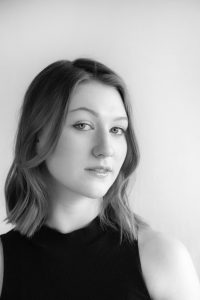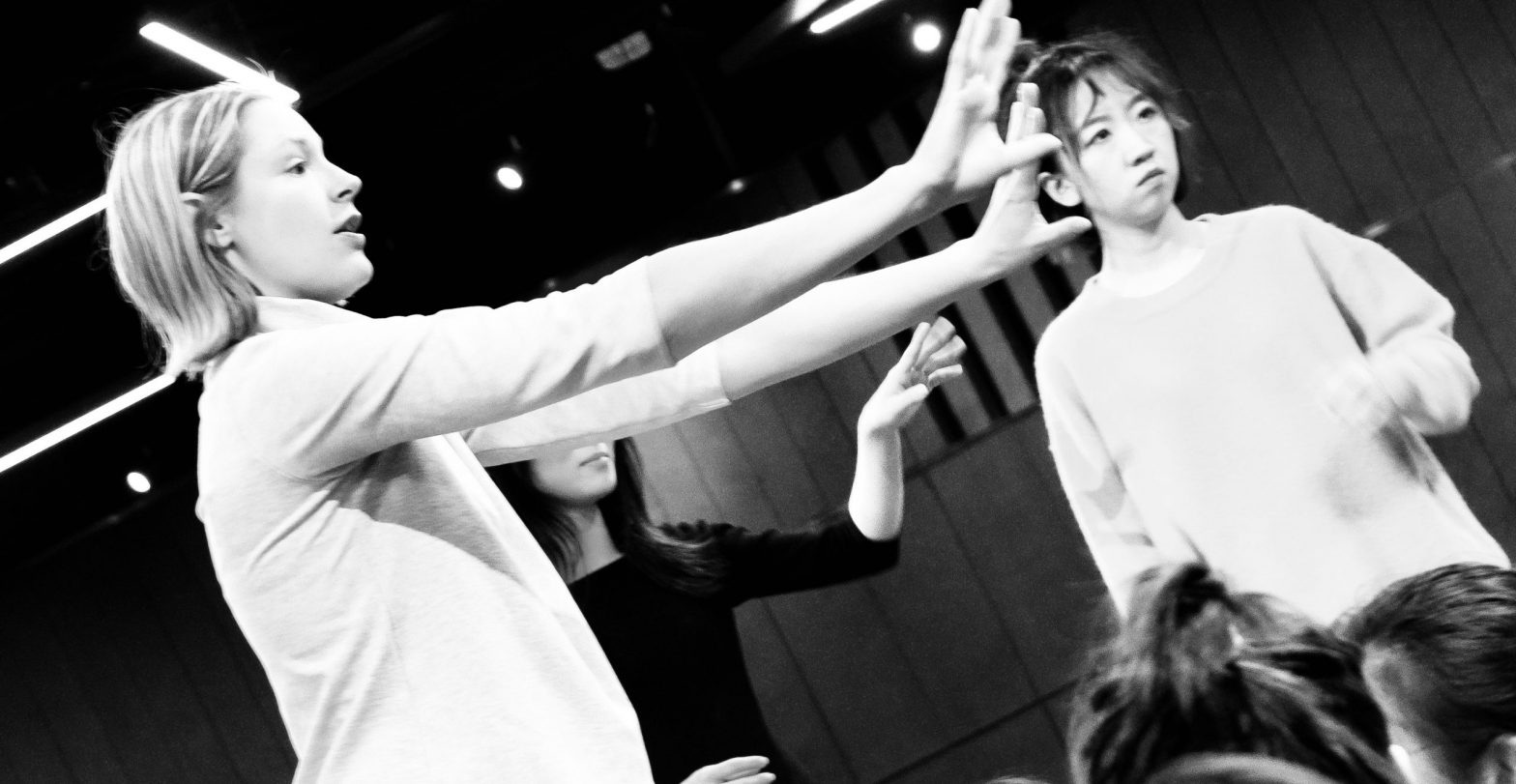TASK 1 – BAGGAGE
TASK 2 – HANDS
TASK 3 – TEXT
FILM TRAILER
The 12 Hour Lab – choreographic workshop
The pattern of our lives has changed in so many ways. For those of us engaged in contemporary dance perhaps more so than others. We, as choreographers, teachers and learners, thrive in the same physical space, and many feel the connection and spark is lost when working in a virtual environment. Dance, with its ability to convey emotion and its cultural power, can act as a powerful tool for communication. Can we find different but still meaningful ways to connect to each other and reach out in a compelling way to a wide audience?
In October 2020 a film inspired by and created from, the material and ideas generated throughout a12-hour ‘lab’ sought to show that some of the embodied excitement of creative connection might still be experienced even in virtual space.
The lab began in August 2020 when a cross-disciplinary team: Choreographer Rachel Wise; Videographer Ruby Gadsby; and sound artist Iain Paxon, worked with an intergenerational group from a variety of movement heritages to play with a ‘score’ designed around our relationship to our environment.
Participants came together in six 2- hour online sessions, spread over two weeks, with visual tasks and soundscapes offered by the choreographer as prompts. These stimuli made use of everyday objects, industrial processes, and materials as a starting point to explore and express how our particular interaction in these small environments has an impact on wider global patterns.
Participants worked both in the whole group and in small breakout room sessions, recording their movement and sounded responses on their own devices in their own homes. A sound score, improvised live by musician Iain Paxon, was layered into the mix. Creative collaborative discussions between participants were given time to develop.
The focus of these sessions was on the experience of working together in an evolving collaborative process, intergenerationally and cross-discipline, using the collective interest in environmental issues as an overarching ‘connector’ for creative discussion and a reciprocal exchange of movement responses, feelings, and ideas.
The choice of a real-life issue helped participants to see their engagement as relevant and meaningful to their own lives, and so have a more emotional stake in the process and outcome. Repeated opportunities to exchange (whether in whole group or small groups) created a strong sense of being on a shared journey and were widely seen as being “inspiring” and “refreshing” by participants. “I couldn’t imagine that we could go through all of these emotions and I felt something quite deep … but it was all through technology”
That last ‘but it was all through technology’ speaks to a deeper sense that virtual engagement is fundamentally lacking in some essential qualities. Reflecting on this as observer and participant, and in conversation with the choreographer, it seems to lie in the experience of ‘Space’: the “movement of the body, the 3D experience, the empathy that ‘moving bodies’ gives the group its energy; the way it takes up the space – gives space – architects space – around you, the viewer, sharing the creation process with other bodies in space.”* Online we are in our own home and our own room and, while we each move freely within this space, we don’t have the shared frame of reference that we have when we are together in the studio. The online window becomes a boundary, and it is more difficult to extend and connect into another window.
The design of this lab went some way towards mitigating the loss of the experience of real and real-time space, in the following ways:
By allowing time for participants to share knowledge, ideas, aspirations, reactions to shared stimuli and experiences – both within small break-out groups and whole group;
By suggesting aspects of movement in shared space: lead and follow, action and reaction, accumulation, giving time for participants to experience these and observe each other;
By allowing for a different, additional, sensory connection through the layering of sound, both voiced and music improvised score;
By using commonplace household objects and materials as a shared reference for the creative response;
By inviting play with perspective within the online frame.
In these ways, it became more possible to move beyond the screen and to feel others’ energy more holistically. As one participant put it “It’s all about authentic conversation and it’s really having an impact for me”
“We get a bit nervous about people leading us as though we won’t have a say, but the ability to offer a journey and allow us to do a journey was brilliantly done”. Choreographers can serve as facilitators, striking a balance between prescribing a movement journey and acting as a guide on that journey. This choreographer offered the group well-structured movement tasks to enhance people’s creative and emotional connections, and freedom to engage in the process to develop a sense of group ownership. This approach went some way towards giving this group (widely ranging in age, training, and experience) that sense of individual agency within which exchange and learning can develop. However, group discussion and evaluation were difficult, and some agency was lost during those moments where the form of technology required one person – usually ‘the host’ – to lead the virtual room. For many of the participants, it meant that it was harder to know when to speak up. For how to create a healthy discourse or how to give space for others. That the balance was well-struck was evident with another participant’s response: “there has been a real impact with the process, with all of us”.
Another strong element in this lab design lay in encouraging ‘playing’ with the online frame – near and far, entering and leaving, working with hands, arms, or face near the camera: the whole body distant in the frame, and specific movement close to the frame. This created shifts in visual-spatial attention that allowed for interesting connections to be made between participants, especially when working in break-out rooms.
Participants were also encouraged to play with viewpoint, filming themselves on their own devices from different camera angles. In this way, the videographer and choreographer would have multiple vantage points on which to hold and shape the visual narrative in the final film. There was an enormous volume of footage generated, and this presented its own challenge as well as the opportunity for the multi- disciplinary team, who were also collaborating online. Different rooms, different lighting, footage from so many different devices, all filmed in different ways, gave rise to some frustration at not having control over how images presented within frames. However, it also gave an opportunity to develop new insights and learning by letting go of the processes undertaken when filming and editing from live studio rehearsal and performance. “It was so different, having something so final ….. everything was improvised, done on that day in response to something in that moment, there was an immediacy, a raw direct engagement.” 1 Myriad moments captured, archived, and shaped, even when not sharing the same physical space.
This project hoped that the physical interpersonal nature of dance could be harnessed, even online, to transform understanding of the world around us and our place in it. “A pile of clothes, a hand in washing-up gloves – sharing the same physical material was a wonderful way for me to imaginatively link to others” This was echoed by the videographer who noticed “even though everyone was in separate spaces you had something that was connecting you in your own space and that’s how it felt for us working on the film as well”.1
The visual and aural stimuli through which we explored our daily habits, routines, and interaction with materials within our home, were also the starting point for discussion: “there is a whole life cycle of a garment, and we are only a moment of that.”, and “I am but a moment in this object’s life”, discussions which imaginatively connected us to the diversity of paths that lead from the particular object to general patterns. Playing with bubblewrap, exploring our emotional response to its suffocating permanence, linking to the ubiquity of plastic in our oceans. And vice-versa, from the general – footage from a recycling centre – gradually resolving through improvised movement responses into a particular object – a piece of clothing. . “… exploring these emotional moments were the strongest bits of this workshop for me”.
Conclusion
Developing intergenerational relationships provided rich material for movement making, finding ways in which the physical interpersonal nature of dance could influence people’s understanding of the world around them. Collaborating across disciplines: movement, music, and videography, added another layer to the rich mix.“everyone here has deepened their engagement with, and consideration of, the emotional relationship to the (environmental) issue”
We found that bringing together people with varied perspectives and experience allowed ideas to ignite in interesting ways. “We shared excitement: a sense of ensemble, of shared vision, and of an alignment of thoughts”. A shared journey began to unfold – leaving one participant to remark “the experience has been one of the richest, perhaps the richest, online workshop I’ve been on”. Creating such a group experience requires choreographers, as facilitators, to have excellent knowledge of their craft, and Rachel Wise was exemplar.
Not being able to have the embodied connection offered by working in a studio was still felt as a loss by all. Not being able to control the images presented – as would have been possible within a studio setting – was also a frustration for the creative team. The final film has been shaped and built on the trust that has been forged between all three members of that team, who have learned to adapt their skill and craft to better serve this virtual platform and address its challenges.
This way of working is different – not played within space and not played with through specification of gaze. “In many ways, it feels like the work explored here is only half complete: more time is needed to develop the possibilities that online space offers.”* This honest appraisal by the Choreographer of the challenges posed by virtual working is still hopeful that, even if beginning efforts are on a small scale, this can lead over time to even deeper engagement.
Some commentators feel that choreographers and film-makers still have a way to go in communicating environmental impact, but perhaps we shouldn’t shy away from this, but continue to be explored through future projects which undertake the issue of climate change, embracing the virtual: “this (work) is in our homes – I think it will stand out ….everyone in their own space will hopefully offer a reflection on our own space and how that affects the rest of the world”.
This project sought not just to mark time until we ‘get back to normal’, rather to explore more fluid ways of working that might enrich our practices overall, and contribute to a shared understanding of the impact we have. Perhaps realising the preciousness of the connections we make – however, we make them – will allow us to shape a new vision for a sustainable future, together. “To make a film of our feelings and realisations about climate …..all I can say is there is hope”
————————————————————-
Lisa Sang Intergenerational Lead on this project and participant
Written in collaboration with creative team: Rachel Wise, Ruby Gadsby, Iain Paxon and advice from Professor Emerita, Christy Adair
All quotes are participants’, with the exception of those marked* (Rachel Wise, Choreographer), and 1 (Ruby Gadsby, Videographer)
…………………………………………..
Meet the Artists
 Rachel Wise’s work is adventurous, intellectually engaging and playful. She creates interdisciplinary art that is Inclusive, Interactive and engages with social, cultural and environmental issues. Audience’s leave feeling engaged, inspired and connected. Rachel works as a movement director, assistant director and choreographer. She collaborates with directors, writers, photographers, filmmakers and musicians with a passion for sharing stories.
Rachel Wise’s work is adventurous, intellectually engaging and playful. She creates interdisciplinary art that is Inclusive, Interactive and engages with social, cultural and environmental issues. Audience’s leave feeling engaged, inspired and connected. Rachel works as a movement director, assistant director and choreographer. She collaborates with directors, writers, photographers, filmmakers and musicians with a passion for sharing stories.

Rachel completed her MA Movement Directing and Teaching at Royal Central School of Speech and Drama, and BA Hons Dance (Performing Arts) at The Liverpool Institute for Performing Arts. As a movement and dance pedagogue her international teaching experience includes Peking University, Bristol Old Vic, The Royal Ballet School and Morley College. Previous engagements as a choreographer and movement director include Sony Pictures Network, Nevill Holt Opera, The Orange Tree Theatre, Beijing Music Festival and Leeds Playhouse.

Ruby Gadsby is a South East based dance and film artist experienced in choreography in a variety of settings. From theatre to site-specific and the screen, alongside dancers from a variety of ages and backgrounds. Recently producing and co-choreographing work for Resolution 2020 at The Place and curating for the international screendance festival Frame Rush. Her film work has been selected as part of The Shut In Dance Festival in conjunction with Dance Camera West.
Currently studying for her MA in screendance at London Contemporary Dance School. Her work creates a sharing and understanding of the human experience through the hybrid of choreographer-filmmaker. The intention is to move and be moved as the work invites you to sit in someone else’s shoes, to question and explore.
Any queries regarding the outcomes of this project, please get in touch with Katie- katie@sussexdancenetwork.co.uk

